The Intel Haswell-E CPU Review: Core i7-5960X, i7-5930K and i7-5820K Tested
by Ian Cutress on August 29, 2014 12:00 PM ESTEvolution in Performance
The underlying architecture in Haswell-E is not anything new. Haswell desktop processors were first released in July 2013 to replace Ivy Bridge, and at the time we stated an expected 3-17% increase, especially in floating point heavy benchmarks. Users moving from Sandy Bridge should expect a ~20% increase all around, with Nehalem users in the 40% range. Due to the extreme systems only needing more cores, we could assume that the suggested recommendations for Haswell-E over IVB-E and the others were similar but we tested afresh for this review in order to test those assumptions.
For our test, we took our previous CPU review samples from as far back as Nehalem. This means the i7-990X, i7-3960X, i7-4960X and the Haswell-E i7-5960X.
Each of the processors were set to 3.2 GHz on all the cores, and set to four cores without HyperThreading enabled.
Memory was set to the CPU supported frequency at JEDEC settings, meaning that if there should Intel have significantly adjusted the performance between the memory controllers of these platforms, this would show as well. For detailed explanations of these tests, refer to our main results section in this review.
Average results show an average 17% jump from Nehalem to SNB-E, 7% for SNB-E to IVB-E, and a final 6% from IVB-E to Haswell-E. This makes for a 31% (rounded) overall stretch in three generations.
Web benchmarks have to struggle with the domain and HTML 5 offers some way to help use as many cores in the system as possible. The biggest jump was in SunSpider, although overall there is a 34% jump from Nehalem to Haswell-E here. This is split by 14% Nehalem to SNB-E, 6% SNB-E to IVB-E and 12% from IVB-E to Haswell-E.
Purchasing managers often look to the PCMark and SYSmark data to clarify decisions and the important number here is that Haswell-E took a 7% average jump in scores over Ivy Bridge-E. This translates to a 24% jump since Nehalem.
Some of the more common synthetic benchmarks in multithreaded mode showed an average 8% jump from Ivy Bridge-E, with a 29% jump overall. Nehalem to Sandy Bridge-E was a bigger single jump, giving 14% average.
In the single threaded tests, a smaller overall 23% improvement was seen from the i7-990X, with 6% in this final generation.
The take home message, if there was one, from these results is that:
Haswell-E has an 8% improvement in performance over Ivy Bridge-E clock for clock for pure CPU based workloads.
This also means an overall 13% jump from Sandy Bridge-E to Haswell-E.
From Nehalem, we have a total 28% raise in clock-for-clock performance.
Looking at gaming workloads, the difference shrinks. Unfortunately our Nehalem system decided to stop working while taking this data, but we can still see some generational improvements. First up, a GTX 770 at 1080p Max settings:
The only title that gets much improvement is F1 2013 which uses the EGO engine and is most amenable to better hardware under the hood. The rise in minimum frame rates is quite impressive.
For SLI performance:
All of our titles except Tomb Raider get at least a small improvement in our clock-for-clock testing with this time Bioshock also getting in on the action in both average and minimum frame rates.
If we were to go on clock-for-clock testing alone, these numbers do not particularly show a benefit from upgrading from a Sandy Bridge system, except in F1 2013. However our numbers later in the review for stock and overclocked speeds might change that.
Memory Latency and CPU Architecture
Haswell is a tock, meaning the second crack at 22nm. Anand went for a deep dive into the details previously, but in brief Haswell bought better branch prediction, two new execution ports and increased buffers to feed an increased parallel set of execution resources. Haswell adds support for AVX2 which includes an FMA operation to increase floating point performance. As a result, Intel doubled the L1 cache bandwidth. While TSX was part of the instruction set as well, this has since been disabled due to a fundamental silicon flaw and will not be fixed in this generation.
The increase in L3 cache sizes for the highest CPU comes from an increased core count, extending the lower latency portion of the L3 to larger data accesses. The move to DDR4 2133 C15 would seem to have latency benefits over previous DDR3-1866 and DDR3-1600 implementations as well.


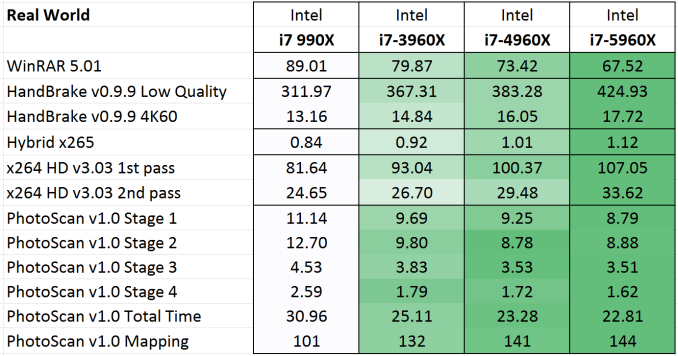


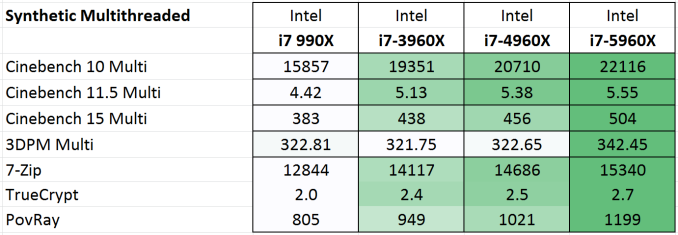

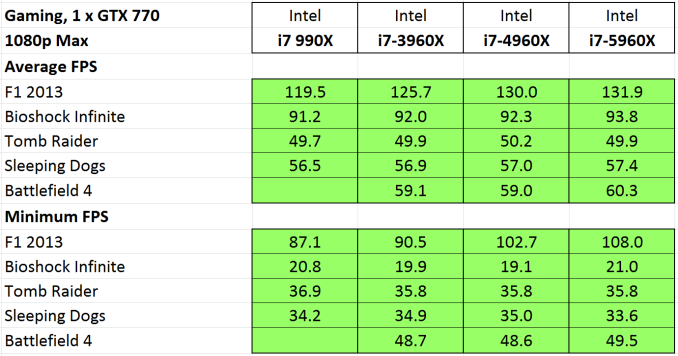
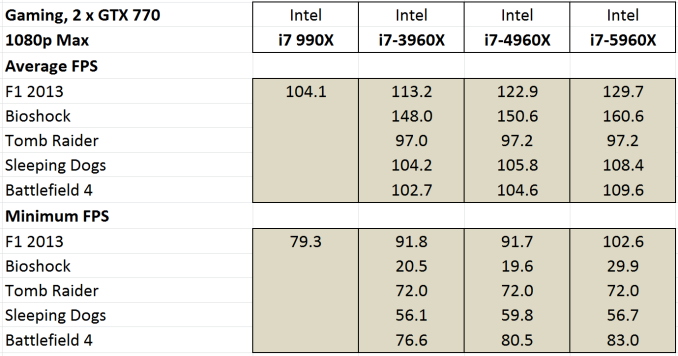
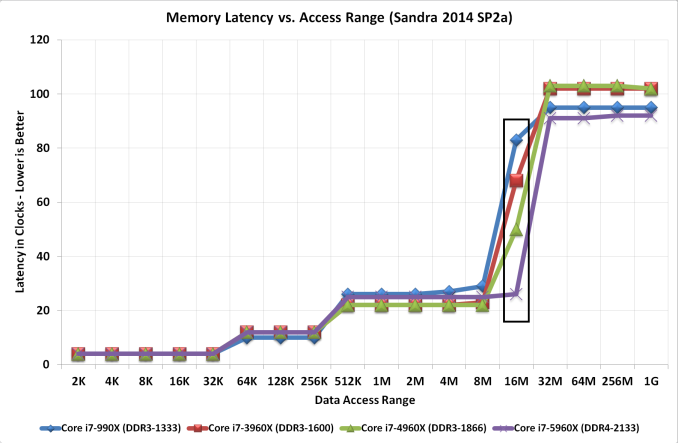








203 Comments
View All Comments
mapesdhs - Saturday, August 30, 2014 - link
I agree; I'd been hoping for a midrange 8-core of some kind, but Intel's once
again shoved up the peformance/price scale purely because it can. Shame.
And IMO the PCIe provision chop with the 5820K is in the wrong direction;
by that I mean the 5820K should have 40, the 5930K have 60 and the 5960X
given 80, something like that. Supporting 4-way native x16 with enough left
over for good storage at the top-end of the CPU range would make its price
much more tolerable, but now the price difference is really just the +2 cores,
at a time when the mid-range chip ought to be an 8-core anyway (remember
the 3930K was an 8-core but with 2 cores disabled, ie. Intel could have
released a consumer 8c a long time ago).
Ian.
PS. twtech, I've benched oc'd 3930Ks quite a lot. What do you use your system for?
garadante - Friday, August 29, 2014 - link
Sheesh... Looking at these performance reviews, I'm questioning whether or not I'll even go for an -E series when I invest in a full upgrade from my 2500k in 2-3 years. In many scenarios the 4790k is at the top or near the top of the rankings due to the higher clock speeds stock/overclocked, yet the platform is much cheaper. Perhaps the 4790k equivalent 2-3 generations from now will be 6-cores, or the IPC will start going up if Intel focuses on it (I hope, but unlikely...). Otherwise these systems are just too expensive for little gain except in CPU bound workloads.l_d_allan - Friday, August 29, 2014 - link
same, with 2600kStevoLincolnite - Friday, August 29, 2014 - link
Same, I'll stick with my Core i7 3930K which happily hits 5ghz.Years ago I never would have thought a CPU released 3 years prior to the latest and greatest would still be able to compete/beat the top chips in most scenarios.
Hopefully Haswell-E's successor gives me the upgrade itch and maybe DDR4 drops in price by then, by then my platform would be 4+ years old.
Intel sure does make it hard to justify plonking down a few grand though. :(
Mithan - Friday, August 29, 2014 - link
I am waiting for skylake next year.Samus - Saturday, August 30, 2014 - link
i7-920 at 3.5GHz/X58 here (first DDR3 chipset)I was going to hold out for the first DDR4 chipset to replace this thing, but...maybe I'll wait for DDR5. Even 5 years later, my first-gen i7 is faster than like 90% of the desktop CPU's out there TODAY. Intel really outdid themselves with Nehalem.
xrror - Saturday, August 30, 2014 - link
Anyone still on 1366, I'd recommend searching around on ebay for xeon X5650 's that are getting dumped for less than $100. If your motherboard is alright with a 191BCK guess what - 4.2Ghz Gulftown with full 6(12) cores. Yeay =)DPOverLord - Sunday, August 31, 2014 - link
I upgraded from a i7 930 to a xeon 5650. Its at 4.6ghz with sli titans in surround (4800 x 2560). Based on this x99 seems to be a worthwhile upgrade albeit an expensive one. Anyone else in my boat?getho - Tuesday, September 2, 2014 - link
So is it worth upgrading an i7 @3.2 GHz to the x5650? My bottleneck is single thread performance (light room likes fast chips).xaml - Saturday, September 27, 2014 - link
I might give this a try once I stuff that Studio XPS 435 MT motherboard sporting an i7 940 into a Prodigy M. I actually had a look at compatible new processors, but they were too expensive. I am not sure if I am going to trust a used offer though.